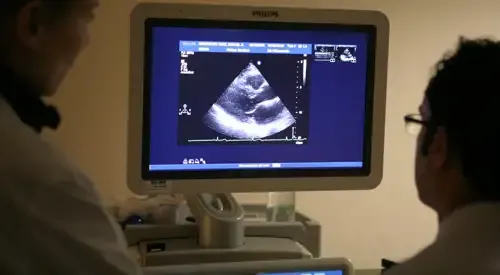Chronic Ischemia Syndrome
"Most of the patients are male smokers over the age of 60".
DR. LUKASZ GROCHOWICZ
PERSON IN CHARGE. VASCULAR SURGERY SERVICE
What is chronic ischemia?
The chronic ischemia is the clinical situation characterized by a deficient blood supply to a certain territory, of progressive establishment.
Chronic ischemia of the extremities appears as a consequence of the slow and progressive decrease of blood flow, and therefore of the oxygen supply, to the muscle groups of the lower limbs during exercise.
Most patients are men over 60 years with atherosclerotic risk factors among which the consumption of snuff takes on special relevance.
Other predisposing factors are obesity, high blood pressure, diabetes, sedentary lifestyle, hypercholesterolemia and situations of hypercoagulability.

What are the symptoms of chronic ischemia?
Due to its chronic character, the clinical presentation is progressive, starting insidiously with alterations in the skin or in the growth of hair or nails, and continuing with the typical symptomatology called intermittent claudication and consisting of pain in the lower extremities after walking a certain distance.
This pain subsides after a few minutes of rest, appearing again when walking that same distance.
In more advanced stages, pain appears even at rest and, if the disease progresses, there may be ulcerous lesions, necrosis and even frank gangrene.
The most common symptoms are:
- Alterations in the skin.
- Alterations in hair growth.
- Alteration in the growth of the nails.
- Pain in the lower extremities.
Do you have any of these symptoms?
You may have a chronic ischemic syndrome
What are the causes of chronic ischemia?
The most frequent cause involved is obilterant arteriosclerosis that manifests itself in the form of narrowing (stenosis) and/or arterial thrombosis.
What is the prognosis of chronic ischemia?
It will depend on each case but, in general terms, and since we are dealing with patients with arteriosclerosis, the key is in the control of risk factors and, above all, in quitting smoking.
The progression of the disease is slow, with a risk of amputation of 1% per year and an intervention rate for critical ischemia of between 6-10% per year.
How is chronic ischemia diagnosed?

In most cases the diagnosis is established with the physical examination of the patient. Palpation of the arterial pulses constitutes the basic exploration.
In spite of this, it is essential to know exactly the repercussion of the disease for which some specific diagnostic tests are necessary, among which the so-called non-invasive techniques and, specifically, the examination by means of continuous doppler, are those indicated in the initial evaluation.
Only if some surgical or interventional attitude is considered, it will be necessary to carry out invasive studies, among which, the arteriography with contrast continues being the most used test.
How is chronic ischemia treated?
The therapeutic objective is to alleviate the symptoms, prevent the progression of the disease and reduce the risk of thrombotic complications.
The treatment will depend on the clinical stage of the patient and the results of the diagnostic tests and may be medical and/or surgical.
In the initial stages of the disease (patients with long-distance claudication) it is usually sufficient to abandon the smoking habit, follow a low-fat diet, avoid overweight, take daily walks, in order to encourage the development of small collateral vessels and adequately control blood pressure and diabetes if any.
These general measures constitute the most important part of the treatment but, in addition, the use of drugs is necessary; the most effective are hemorrheological agents and antiplatelet agents.
In more advanced phases (claudication at close range, pain at rest or presence of trophic lesions), in addition to the measures already mentioned, it is necessary to consider a more aggressive, surgical or interventional attitude.
On some occasions the lesions that cause the symptoms can be resolved by endovascular surgical techniques (angioplasty, stenting, etc.), but more frequently it is necessary to perform surgical revascularization by means of bypasses.
This technique uses as grafts the patient's own veins (generally saphenous vein) or synthetic material (Dacron, PTFE). In very advanced cases or if attempts to save the limb fail, amputation may be necessary.
Where do we treat it?
IN NAVARRA AND MADRID
The Vascular Surgery Service
of the Clínica Universidad de Navarra
The Vascular Surgery Service of the Clinic has the latest technology for the diagnosis, treatment and surgery of vascular pathologies. Our wide experience, framed in the quality care environment of the University of Navarra Clinic, allows us to offer the patient the most effective and innovative treatments.
We have an operating room specialized in vascular surgery, equipped with advanced equipment for the surgical treatment of the most important vascular diseases.
We are pioneers in endovascular brachytherapy, localized radiotherapy to treat tumors, which has been practiced in the world on very few occasions.
Diseases we treat
- Diseases of the aorta
- Carotid diseases
- Chronic venous insufficiency (varicose veins)
- Ischemia of lower extremities
- Varicose ulcers

Why at the Clinica?
- En menos de 24 horas podemos realizar las pruebas necesarias para establecer el diagnóstico y el planteamiento del tratamiento.
- Área de Flebología pionera en España en el tratamiento de varices con microespuma.
Our team of professionals
Specialists in Vascular Surgery with experience in the treatment of chronic ischemia
Cardiovascular Checkup
ICAP
INTEGRATED CARDIOVASCULAR
ASSESSMENT PROGRAM
A new approach to cardiovascular risk
The only checkup that incorporates the latest diagnostic imaging technology to accurately quantify your risk of stroke and myocardial infarction.
Thanks to the exclusive dedication of our professionals, we are able to perform the ICAP checkup in less than 48 hours with a highly accurate diagnosis.



